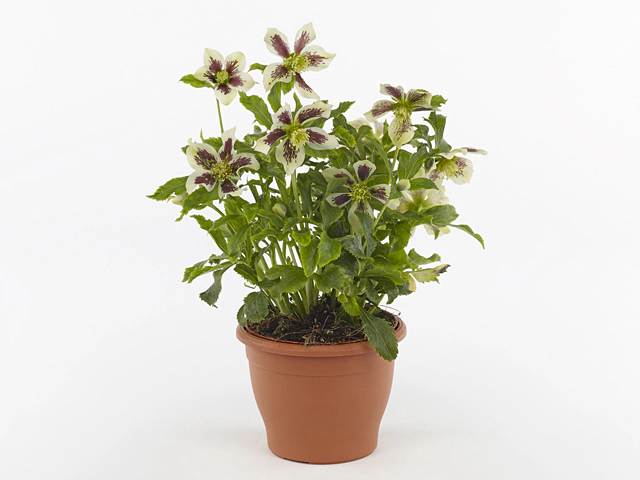Helleborus orientalis Halcyon White Spotted

| Flower type | Single |
| Leaf margin | Serrate |
| Winter hardness | Good (USDA-zone 5, 6) |
| Flower color | Brown-brown red-178B; White-white-NN155A |
| Flower diameter | 6,5 - 7 cm |
| Plant height | 20 - 30 cm |
| Flowering month(s) | January; February; October; November; December |
| Leaf size | 7,5 - 10 cm |
| soil pH requirement | Alkaline (pH > 7,5); Slightly acidic (pH 4,5 - 6,5); Neutral (pH 6,5 - 7,5) |
| Light conditions | Semi-shades |
| Leaf division | Digitate-lobed |
| Leaf, main color | Dark green |
| Leaf colour, pattern | Unicolored |
| Flower color distribution | Bicolored; Feathered |
| Toxicity (if consumed) | Toxic |
| Moisture requirements | Well-drained; Moist |
| Soil type | Humus rich |
The Helleborus orientalis Halcyon White Spotted, also known as the Hellebore, is a beautiful and unique flower that is sure to catch the eye. With its single flower type and serrated leaf margin, it adds a touch of elegance to any garden or landscape.
One of the standout features of this plant is its winter hardness. It is well-suited for regions in USDA zones 5 and 6, making it an excellent choice for gardeners in colder climates. This means that even in harsh winter conditions, the Hellebore can continue to thrive and bring beauty to the surroundings.
The flower of the Helleborus orientalis Halcyon White Spotted is a striking combination of brown-red and white, creating a bicolored and feathered appearance. The flowers have a diameter of 6.5 to 7 cm, making them a perfect size to create a stunning display. They bloom during the months of January, February, October, November, and December, adding color and life during the colder months when many other plants are dormant.
The Hellebore plant itself reaches a height of 20 to 30 cm, making it a compact and manageable addition to any garden. The leaves are digitate-lobed and have a dark green main color with a unicolored pattern. This adds depth and texture to the overall appearance of the plant, enhancing its visual appeal.
When it comes to soil pH requirements, the Hellebore prefers slightly acidic to alkaline soil. It can tolerate a pH range of 4.5 to 7.5, making it adaptable to different soil conditions. However, it thrives best in well-drained and moist soil types that are rich in humus.
In terms of light conditions, the Hellebore prefers semi-shade, meaning it thrives in areas with partial sunlight rather than full sun. This makes it a great choice for gardens that have areas with filtered sunlight or limited exposure to direct sunlight.
It's important to note that the Hellebore is toxic if consumed, so caution should be exercised when planting it in areas where pets or children may be present. However, as long as basic precautions are taken, this plant can be enjoyed without any issues.
Overall, the Helleborus orientalis Halcyon White Spotted is a versatile and visually striking plant that brings beauty and elegance to any garden or landscape. With its winter hardiness, unique flower color, and compact size, it is a wonderful addition to gardens in colder climates or those seeking a touch of sophistication.
Market availability index by month:
| Jan. | Feb. | Mar. | Apr. | May | Jun. | Jul. | Aug. | Sep. | Oct. | Nov. | Dec. |
|---|---|---|---|---|---|---|---|---|---|---|---|
| 2 | 1 | 1 | 1 | 1 | 1 | 1 | 1 | 1 | 3 | 4 | 3 |